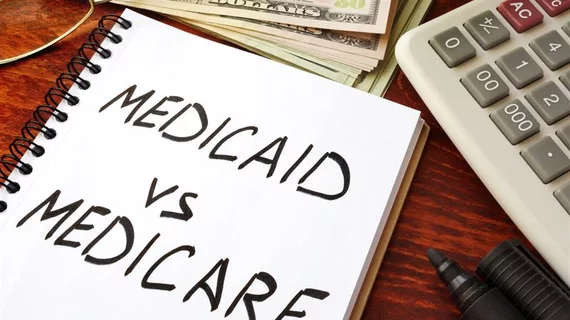Radiology experts say state Medicaid rates must increase to improve imaging access
Radiology experts assert that state Medicaid payment rates must increase to help improve vulnerable patients’ access to imaging.
Reimbursement for radiology services varies widely among insurers, researchers noted Wednesday in JACR. Commercial reimbursement is roughly 144% of Medicare, for example, while Medicaid is 72% of the latter, according to previous research. However, Medicaid can fluctuate further, with each state-run program setting its own rates for the low-income health insurance program.
Neiman Health Policy Institute experts sought to understand how higher or lower physician reimbursements in Medicaid might impact access to care. They found that patients residing in states with higher Medicaid reimbursement rates were more likely to undergo medical imaging.
“While utilization is not a direct measure of access, it is reasonable proxy,” study co-author Elizabeth Rula, PhD, executive director of the ACR-affiliated policy institute, said in a statement. “Our finding was that states with lower reimbursement systematically have less Medicaid imaging utilization than higher-reimbursement states, strongly suggests that reimbursement influences access to care,” she added.
To standardize Medicaid payments for cost differences in each state, the research team computed the ratio of Medicaid to Medicare reimbursement. Medicare uses the same reimbursement rate nationally, with local economic adjustments. Across nearly 49 million Medicaid beneficiaries, the median payment rate was about $0.82 spent on computed tomography and X-ray (or 82%) compared to each $1 spent in Medicare. The median rate was about $0.76 for nuclear medicine and $0.85 for ultrasound. For Medicaid beneficiaries, the probability of undergoing CT or MRI was about 26% lower when living in states that reimbursed less for the exams. Similarly, the chances were about 21% lower for ultrasound and 32% lower for regular radiography.
Researchers also charted “substantial” variation in payment rates from one state to the next. For instance, the lowest-paying one-fourth of states reimbursed at 74% or less than the Medicare rate for radiography. That’s compared to the highest-paying quarter of states, which paid 97% to more than 100% of the Medicare X-ray rate. Radiography also saw the largest impact of reimbursement on utilization, which was 38% greater in higher-paying states.
“The implication of our study is that increasing state Medicaid reimbursement is a logical option for improving access to care,” Rula said. “As a safety net program, Medicaid serves low-income Americans and a disproportionate percentage of beneficiaries who are Black or Hispanic. Eliminating Medicaid reimbursement gaps may reduce the healthcare and outcome disparities experienced by these underserved groups.”
While the likelihood that a patient would undergo any imaging decreased with lower reimbursement, each imaged patient had the same number of exams, on average, regardless of reimbursement, with the single exception of nuclear medicine. The authors did not attempt to discern whether the additional imaging delivered in higher-Medicaid-reimbursement geographies was of value or healthcare waste. It also is unclear if states with lower Medicaid rates have less imaging utilization for reasons other than reimbursement.
“Reducing these reimbursement differences by increasing Medicaid reimbursement is important for reducing access and utilization disparities for Medicaid patients, because having Medicaid coverage is not synonymous with equal access to care,” the authors concluded.

